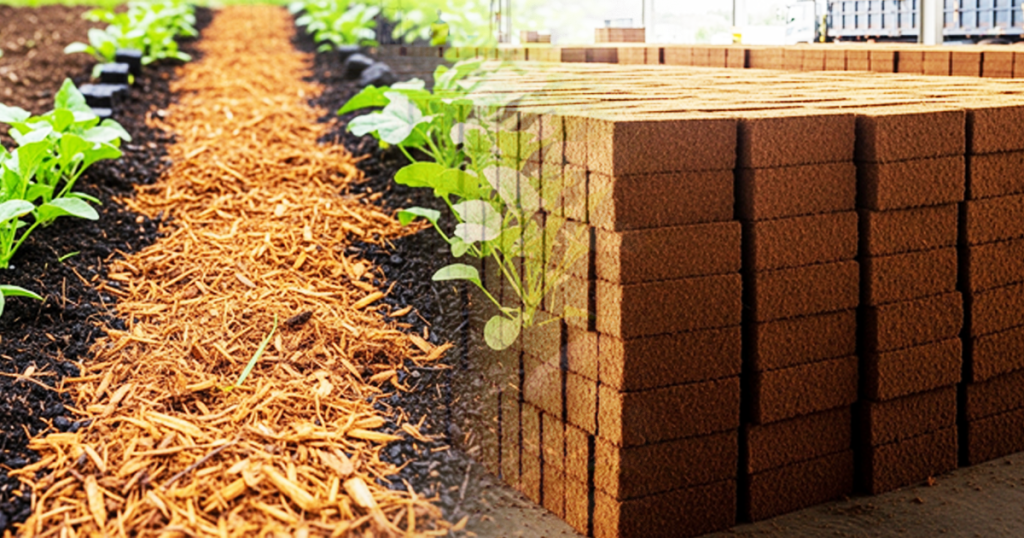A Researcher’s Perspective on Sustainable Agriculture Innovation
In the face of increasing climate volatility, global agriculture finds itself at a crossroads. Droughts, irregular rainfall, and declining soil fertility are rapidly eroding conventional farming systems.
As a researcher focused on substrate technology, I’ve explored various alternatives, and one material keeps rising to the top cocopeat. Cocopeat, or coir pith, is the fibrous by-product of coconut husks.
While traditionally discarded, recent studies show its remarkable potential as a soil substitute. It retains moisture efficiently, provides excellent aeration, and supports beneficial microbial life. But its true value may lie in helping farmers adapt to a changing climate.
Moisture Retention: A Game Changer in Dry Zones
One of cocopeat’s most promising attributes is its high water-holding capacity. In trials conducted across arid zones in Southeast Asia and Africa, crops grown in cocopeat-amended soils required up to 50% less irrigation.
This is due to cocopeat’s sponge like structure, which retains water while allowing excess to drain, preventing root rot. This characteristic is vital for regions where water scarcity is becoming the new normal.
In areas hit by prolonged dry spells, cocopeat can help maintain crop yield without depleting local water tables. The implications for sustainable agriculture in water-stressed regions are enormous.
Supporting Healthy Root Systems and Soil Microbiology
Beyond water retention, cocopeat offers an ideal medium for root development. It has a neutral pH and is free of pathogens if properly processed. In hydroponic systems and container farming, cocopeat provides consistent aeration that encourages robust root systems.
Moreover, research from multiple agroecological projects indicates that cocopeat can foster beneficial microbes. These microbes enhance nutrient availability and suppress disease, reducing the need for chemical fertilizers and pesticides. In an era of rising environmental consciousness, this makes cocopeat an appealing organic solution.
Climate Adaptability and Carbon Footprint
Unlike peat moss, which is harvested from slow-regenerating bogs, cocopeat is a renewable by-product of the coconut industry. Utilizing cocopeat reduces agricultural dependence on finite resources while offering a more sustainable carbon footprint. It’s compostable, biodegradable, and widely available in tropical countries.
Countries like India, Sri Lanka, and Indonesia already produce tons of coconut waste annually. With proper investment in processing infrastructure, this agricultural waste could become a global solution to climate-smart farming.
Challenges and Areas for Further Research
Despite its promise, cocopeat isn’t without challenges. Salinity levels must be closely monitored, especially when derived from coastal coconut farms. Improperly washed cocopeat can contain high levels of sodium and potassium, which can harm sensitive crops.
Furthermore, uniform quality standards are still lacking in many regions. As researchers, we must develop protocols to optimize its processing and ensure safe usage across diverse climates and crop types. We also need more long-term field studies to measure its efficacy under extreme weather events.
From Lab to Land: Scaling Cocopeat Use
Bridging the gap between research and practice requires collaboration. NGOs, governments, and private sectors must work together to make cocopeat accessible and affordable. Extension services should be trained to educate farmers on best practices, from substrate preparation to blending with local soils.
In my own projects, integrating cocopeat with organic compost has yielded encouraging results in smallholder farming systems. Productivity improved, soil degradation slowed, and most importantly, farmer resilience increased.
A Natural Ally for a Changing Climate
As climate unpredictability reshapes global food production, cocopeat may offer more than just a planting medium it could be a tool of resilience. From enhancing soil health to reducing water dependency, this humble by-product of the coconut may well be one of agriculture’s most overlooked assets.
Future research must continue to refine its applications, but early indicators are strong. For climate-resilient crops, cocopeat could indeed hold the key.







